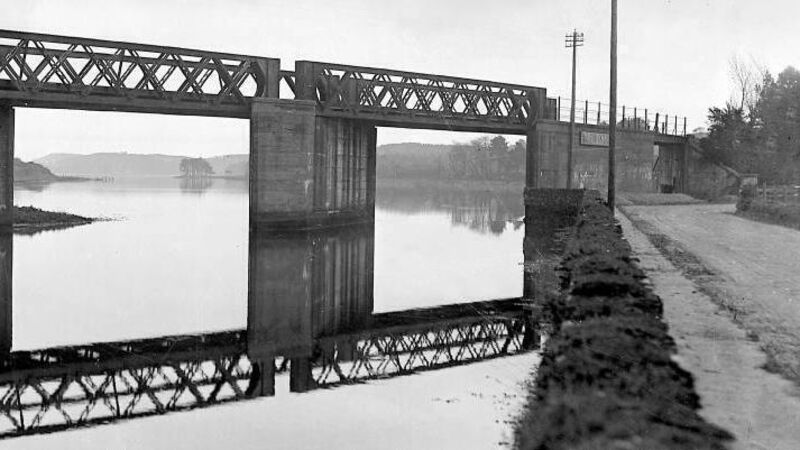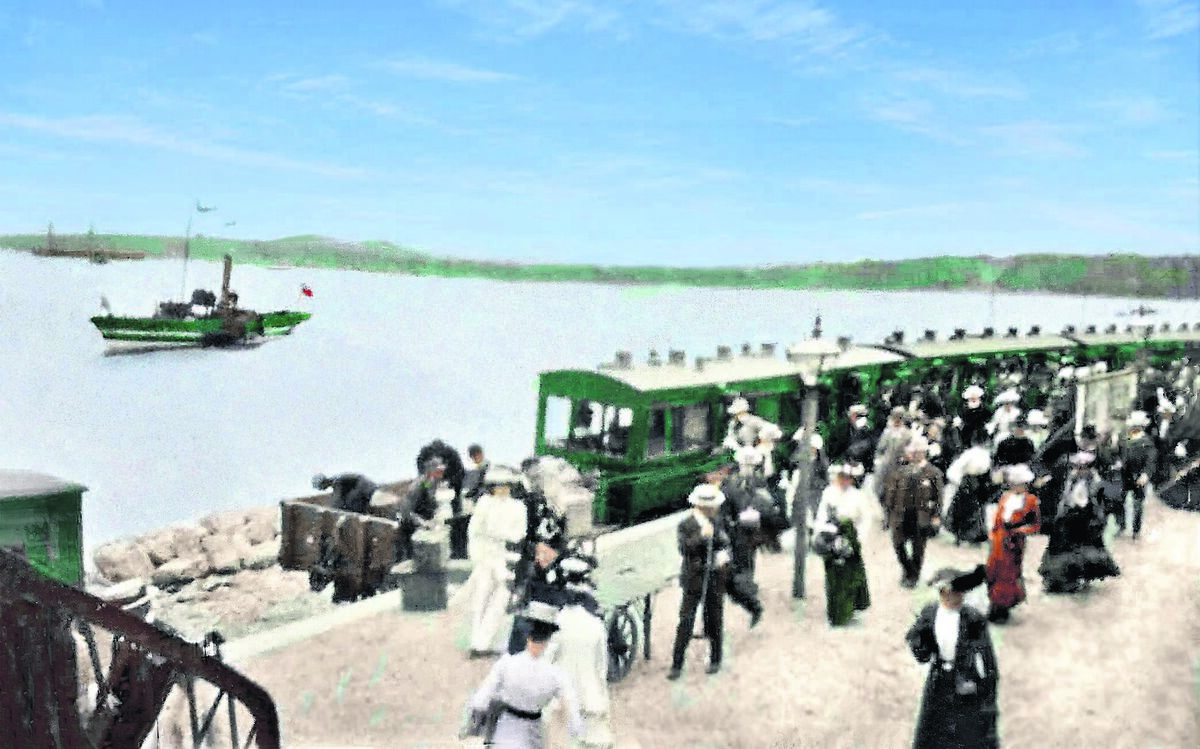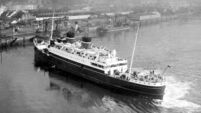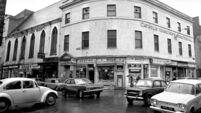Throwback Thursday: Days when you got on a train to Crosshaven

The old railway bridge at Carrigaline leading to Crosshaven, pictured in 1927
Throwback Thursday reader Tom Jones, who wrote so feelingly of his own Cork childhood last week, has added another reminder about the scents and aromas of yesteryear.
“Oh, the bakeries! They were everywhere, and quite a few of them on Shandon Street itself in the days of my youth,” recalls Tom.
“Can’t you just imagine the temptation to childish tummies as the baker put out his fresh loaves and buns while reluctant scholars were toiling past on their way to school?
“How can we ever forget the exotic aromas emanating from Woodford Bourne back in those days of yore,” he adds.
“And I agree, the building itself as an architectural icon of Cork deserves far more than an international fast-food chain, regardless of the brand.”
Absolutely, Tom. That proud 1875 structure is, fortunately, listed, and so it should be.
During its heyday, more than 10 years’ supply of whiskey, casks containing over a million bottles of wine, sherries and ports, and more than 50,000 gallons of choice Cork and Dublin whiskies, Scotch whiskies and fine French brandies were all stored in wet and dry cellars underneath.
And you can still see the clear lettering over each window, listing all the elegant options for fine dining back in an earlier era, from tea (Indian or China) and freshly-roasted coffee to rare wines and luxury foodstuffs.
How times and tastes change!
Do you recall the query that Tom posed last week?
He said: “Beneath the steps leading from the Lower Road to Summer Hill, there exist what appear to be three arched tunnel entrances. They were bricked up to just half their entrances, and as an adventurous child I climbed over them. But they only went in a little way, so I can’t help but wonder what their purpose was. It must be hidden somewhere in the history of Cork.”
I went to a totally reliable source on this, my brother Tom.
“Oh, those archways under the Forty Steps leading up to Clifton Terrace?” said Tom. “They’re just that – arches, built to bring the steps up from the new higher level of the Lower Road, built up when the railway tunnel was created.
“Yes, they were half open then, so any adventurous kid could climb in, but they only went back as far as the cliff face, which wasn’t very deep.”
But Tom remembered something else.
“There was this place in Douglas Street, Carroll’s Yard. Charniker used to have his scrap metal business there. After him, the next tenant was a chap who fixed cars, and he wanted to dig a pit so he could get under the vehicles.
“When he started digging, he quite quickly discovered a deep hole, and when the archaeological crowd came down from UCC to research it, they found what had once been a wine vault below the street.”
Now why would that be there?
A faint memory tugged at the corner of my mind. Nearby Cove Street. Not Cobh, Cove. Why?
Well, because there was once a little cove or harbour here, almost certainly used by the Vikings as a handy place to moor their ships, and where, in later times, goods were shipped up to a small monastery and the church of St Sepulchre (sited where Douglas Street is today).
The original natural harbour would have been bounded by Cove Street, Meade Street, Mary Street, and Sullivan’s Quay.
Do those wine vaults under Carroll’s Yard hold memories of heavy casks of wine being rolled in from the tiny quayside, while monks rubbed their hands and thought of a welcome addition to that night’s sparse dining?
I had better take in that area on my next ramble around the city, and see if I can spot any clues, any faint trace of old pathways, cobblestones, etc.
It’s amazing what you can spot if you really look up, down, and around, everywhere you go. Street names are such a great clue.
Meanwhile, reader Tim Cagney was interested in recent Throwback Thursday discussions on the subject of those hidden tunnels and passageways around the Victorian Quarter.
“Are you familiar with the mysterious concealed passageway on Wellington Road?,” he asks.
“A few paces downhill from the old St Patrick’s Hospital, there is a right-hand turn leading to a terrace of houses. That terrace actually fronts on to a walled passageway, which has narrow slits in the wall on the Wellington Road side.
“I well remember peering through a slit one day and seeing what I thought was a human skull hanging on the wall. (It was actually a shaft of light, coming through another slit.) I got the fright of my life, and legged it to the safety of Gardiners Hill and home. Any information?”
Back to my brother, Tom, again.
“Yes, I know those slits in the wall. There is a bricked-up entrance way there too. Been shut up for goodness knows how long, but about 20 or 30 years ago, the council opened up that entrance for some reason or another, and I made sure to pop in and have a look around while it was open.
“It was a good width for walking, and high enough too, but a dead end. Went along about the length of the first garden on Waterloo Terrace, but I have no idea what it was first intended for.
“The slits in the wall were obviously to let in enough light to see your way, but where it was going, and why, your guess is as good as mine!”
My brother is now off in eager hunting mode to track down two hidden wells that he has heard of in the area. No information offered on those until he has them located!
You never know what you are going to find in your own small patch of Cork. Wells wouldn’t be unusual at all back in the day, but since we all got piped water, we tend to forget about the old ways of getting hold of a bucket of the stuff for boiling the kettle and washing the kids. The city is probably full of them.
Some might be considered sacred wells with special properties (think Sunday’s Well, The Well Road, etc), but the ordinary kind were both essential and plentiful.

Now, back to those famous Rock Steps on the Northside.
This writer made a special trip there last week and walked them down and up again. In fact, I couldn’t complete the lowest section, going on to the North Mall, as the gate was locked, but I came up a flight and turned left along a delightful row of little 19th century cottages to find the next laneway down. Is that gate permanently locked? Maybe it’s a security feature.
The important thing is, I wanted to find that ‘Devil’s Chair’, as mentioned by readers in recent weeks. Would this photo I took on the facing page, in a recess in the red sandstone, be it, do you think?
I don’t know if you can see it clearly, but there is certainly a recess there in that classic Cork red sandstone that one (or two) small children could squash into for fun. But we would welcome a firm confirmation from those who lived close by. Fintan Bloss, are you there? These details are vitally important to those of us who love this city’s history.
Now, a postscript from Tim Cagney, who talked about Wellington Road further up this page.
He mentioned a Facebook page on Crosshaven, [https://www.facebook.com/crosshavenhistory] and commented in surprise: “I never actually knew Crosser HAD a railway station!”
Well, it certainly did, Tim, and must have brought many happy Corkonians to the seaside back in the early 20th century.
It was the last stretch to be built on the Blackrock and Passage West line, which opened in 1850, with steamers on hand at the Passage terminus to take travellers on to Monkstown, Cobh, Haulbowline, Aghada, Currabinny, Ringaskiddy, and Crosshaven.
It cost 6d for first class and 4d for second class to Passage, with a horse-drawn omnibus onward to Monkstown for an extra 1d.
No, I am not translating that into new money. A penny was a penny back then, and bought a whole lot more than it would do today!
Getting the train as far as Crosshaven didn’t happen until June 1, 1904. By the summer of 1909, there were 11 trains each day to and from the seaside resort.
For almost 30 years, Corkonians could go up and down to Crosshaven by train, but as happened everywhere else, the increase in road traffic signalled the decline of the railways. Unable to compete, the Monkstown to Crosshaven section of the line closed on May 31, 1932.
Wouldn’t it be lovely to have some memories from those who actually used this line back in the early 20th century?
Alas, most, if not all, will have gone ahead by now, but we have managed to track down a letter written by a small boy in 1908 after a special charity outing to the sea for city children.
“The train left Cork at 10.45am and arrived there at 11.45am. When we arrived, most of us walked to Church Bay or Graball Bay. It is the nicest place I ever was in.
“I was watching the Atlantic steamers for nearly an hour. The scenery about Crosshaven is really beautiful.
“We then walked through the soldiers’ camp field and visited most of the camps there. Have you ever been there, Granny? If not, I should think it would be a very nice place for you to spend a holiday, but as you are so very old you would want someone to show you around.
“At one o’clock the dinner bell rang. I did not hear it as I was too far away. After a time I returned, but all the people had nearly eaten their dinner. I managed to get mine, and was finished as soon as any of the others.
“After dinner, we went looking for cockles and crabs. At 3.30pm we had a few games, such as cricket, rounders, and football. About 4.30pm the teachers of the Sunday schools threw up biscuits and sweets for us.
“We had our tea at 5 o’clock, after which we had some races. My youngest sister, who is five years old, won a pair of doll’s shoes and a doll.
“At 6.30pm, we returned to the station and at 7 o’clock the train left for home. I was very tired after the day, but I enjoyed it immensely.

“I remain, your loving grandson, Herbert.”
Formally and carefully written, but hidden within those words must have been a day of wonders, of delights, of sea air and sunshine, unusual foods, races, prizes, and above all, that train journey from the city to Crosshaven and back.
Oh, would that we could take the same rail route today.
Over in Cornwall and Devon in south-west England, they are fortunate enough to still have little sea coast railway lines operating. I suppose it’s really too late to bring ours back?
What are your memories of unforgettable summer holidays? Email jokerrigan1@gmail.com or leave a message on our Facebook page: www.facebook.com/echolivecork.







